By Marcus Hoo & Jeremy Ho
As an Employer
You can offer resources for both broader mental health and those who need help with coping skills, managing stress, and building up resilience. Strengthening their overall mental fitness is important for them to be both happy individuals, but also productive contributors to your team.
- Employee assistance program (EAP). An EAP is a work-based program that is designed to assist employees with personal or work-related problems that may be hurting their job performance or well-being. The program is provided to employees at no cost and are often delivered via phone, video-based, online chatting, e-mail or face to face. They can also be used to assist with issues like relationship challenges, traumatic events, legal problems, wellness matters, and a broad range of other issues.
- Check out our Aventis Wellness’ EAP services on our website: https://aventiswellness.com/employee-assistance-programme/
- Relaxation spaces. Dedicated relaxation spaces for employees to have the opportunity for mid-day breaks to unwind and de-stress. What is also equally important is making it culturally acceptable to take breaks and use these spaces. Leaders and managers should also be encouraged to set the tone for such spaces.
- Mental health self-assessment tools available to all employees. Self-assessment tools provide questionnaires and tools to assess mental health concerns.
- Such tools can include, but are not limited to:
- Mental health meter quiz
- Work-life balance quiz
- Online mental health check-up
- Mood assessment checklist

- Free or subsidized clinical screenings for depression. Employers should provide clinical screenings from mental health professionals and provide feedback and clinical referrals when appropriate. Otherwise, the effort of seeking evaluation and treatment can be a barrier.
- Health insurance with mental health benefits at no or low out-of-pocket costs. Employers should provide free or relatively inexpensive health care coverage for prescription medications and mental health counselling. This allows employees to take better care of themselves knowing that medical care is always available and cost efficient
As an Employee
Employees should encourage employers to offer stress management education and mental health programs that meet their needs and interests in order to promote mental well-being at work.
Additionally, employees should also understand policies on how to take a mental health break from work in the event the need arises. Here are some examples employees can use.
- Share experiences with others. Employees can share their own experiences with other co-workers when appropriate to help reduce the stigma around mental health. Unless you feel very comfortable with whoever you are talking to, this is more about sharing your humanness than getting into details — co-workers can’t substitute for mental health professionals.
- Practice coping skills during the workday. To cope with daily work stressors, employees can practice skills that promote healthier mindsets, relationships, and self-image.
- Some tools may include but are not limited to:
- Deep breathing
- Healthy communication
- Prioritization and focusing on one task at a time to avoid being overwhelmed
- Using positive self-talk
- Take part in employer-sponsored activities. Employees should be encouraged to take advantage of employer programs. This enables them to learn skills and obtain the support that they need.
- Self-care on lunch breaks. Daily lunch breaks are not only opportunities to eat, but they’re also the perfect opportunity to practice self-care.
- Practicing self-care during lunch breaks can include but are not limited to:
- Listening to inspirational podcasts
- Meditating
- Deep breathing
- Going for a short nature walk
- Taking care of their physical health. Employees can set themselves up for mental health success by taking care of their physical health, which includes eating healthy meals, exercising regularly, and getting plenty of sleep.

- Nurturing relationships. Nurturing social connections at work is vital to preventing social isolation and loneliness in the workplace. Having social connections will also mean that you have people to fall back to if you encounter a hurdle at work.
Summary
When it comes to promoting well-being at work, creating proactive options that help people improve and maintain their mental health day-to-day is key to helping employees flourish.
Therefore, it is vital for both employers and employees alike to make sure the company staff’s mental health is up to the task.
Finally, Positive Workplace Culture is a holistic effort. It requires the initiative and effort from everyone within the organization to play a part in cultivating a good workplace and healthy employment wellbeing. Let us start and spur each other on to create a much healthier workplace.

